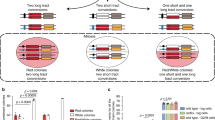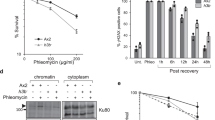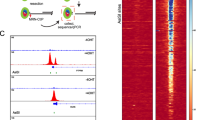Abstract
In response to ionizing radiation, the MRE11/RAD50/NBN complex re-distributes to the sites of DNA double-strand breaks (DSBs) where each of its individual components is phosphorylated by the serine–threonine kinase, ATM. ATM phosphorylation of NBN is required for the activation of the S-phase checkpoint, but the mechanism whereby these phosphorylation events signal the checkpoint machinery remains unexplained. Here, we describe the use of direct protein transduction of the homing endonuclease, I-PpoI, into human cells to generate site-specific DSBs. Direct transduction of I-PpoI protein results in rapid accumulation and turnover of the endonuclease in live cells, facilitating comparisons across multiple cell lines. We demonstrate the utility of this system by introducing I-PpoI into isogenic cell lines carrying mutations at the ATM phosphorylation sites in NBN and assaying the effects of these mutations on the spatial distribution and temporal accumulation of NBN and ATM at DSBs by chromatin immunoprecipitation, as well as timing and extent of DSB repair. Although the spatial distribution of NBN and ATM recruited to the sites of DSBs was comparable between control cells and those expressing phosphorylation mutants of NBN, the timing of accumulation of NBN and ATM was altered. Serine-to-alanine mutations that blocked phosphorylation resulted in delayed recruitment of both NBN and ATM to DSBs. Serine-to-glutamic acid substitutions that mimicked the phosphorylation event resulted in both increased and prolonged accumulation of both NBN and ATM at DSBs. The repair of DSBs in cells lacking full-length NBN was significantly delayed compared with control cells, whereas blocking phosphorylation of NBN resulted in a more modest delay in repair. These data indicate that following the induction of DSBs, phosphorylation of NBN regulates its accumulation, and that of ATM, at sites of DNA DSB as well as the timing of the repair of these sites.
This is a preview of subscription content, access via your institution
Access options
Subscribe to this journal
Receive 50 print issues and online access
$259.00 per year
only $5.18 per issue
Buy this article
- Purchase on Springer Link
- Instant access to full article PDF
Prices may be subject to local taxes which are calculated during checkout





Similar content being viewed by others
References
Weemaes CMR, Hustinx TWJ, Scheres JMJC, van Munster PJJ, Bakkeren JAJM, Taalman RDFM . A new chromosomal instability disorder: the Nijmegen breakage syndrome. Acta Paediatr 1981; 70: 557–564.
Taalman RDFM, Hustinx TWJ, Weemaes CMR, Seemanova E, Schmidt A, Passarge E et al. Further delineation of the Nijmegen breakage syndrome. Am J Med Genet 1989; 32: 425–431.
Varon R, Vissinga C, Platzer M, Cerosaletti KM, Chrzanowska KH, Saar K et al. Nibrin, a novel DNA double-strand break repair protein, is mutated in Nijmegen Breakage Syndrome. Cell 1998; 93: 467–476.
Carney JP, Maser RS, Olivares H, Davis EM, Le Beau M, Yates JR et al. The hMre11/hRad50 protein complex and Nijmegen breakage syndrome: linkage of double-strand break repair to the cellular DNA damage response. Cell 1998; 93: 477–486.
Matsuura S, Tauchi H, Nakamura A, Kondo N, Sakamoto S, Endo S et al. Positional cloning of the gene for Nijmegen breakage syndrome. Nat Genet 1998; 19: 179–181.
Maser RS, Zinkel R, Petrini JH . An alternative mode of translation permits production of a variant NBS1 protein from the common Nijmegen breakage syndrome allele. Nat Genet 2001; 27: 417–421.
Lins S, Kim R, Kruger L, Chrzanowska KH, Seemanova E, Digweed M . Clinical variability and expression of the NBN c.657del5 allele in Nijmegen Breakage Syndrome. Gene 2009; 447: 12–17.
Taalman RDFM, Jaspers NGJ, Scheres JMJC, de Wit J, Hustinx TWJ . Hypersensitivity to inonizing radiation in vitro, a new chromosomal breakage disorder, the Nijmegen breakage syndrome. Mutat Res 1983; 112: 23–32.
Jaspers NGJ, Taalman RDFM, Baan C . Patients with an inherited syndrome characterized by immunodeficiency, microcephaly, and chromosomal instability: genetic relationship to ataxia telangiectasia. Am J Hum Genet 1988; 42: 66–73.
Savitsky K, Bar-Shira A, Gilad S, Rotman G, Ziv Y, Vanagaite L et al. A single ataxia telangiectasia gene with a product similar to PI-3 kinase. Science 1995; 268: 1749–1753.
Desai-Mehta A, Cerosaletti KM, Concannon P . Distinct functional domains of nibrin mediate Mre11 binding, focus formation, and nuclear localization. Mol Cell Biol 2001; 21: 2184–2191.
Luo G, Yao MS, Bender CF, Mills M, Bladl AR, Bradley A et al. Disruption of mRad50 causes embryonic stem cell lethality, abnormal embryonic development, and sensitivity to ionizing radiation. Proc Natl Acad Sci USA 1999; 96: 7376–7381.
Xiao Y, Weaver DT . Conditional gene targeted deletion by Cre recombinase demonstrates the requirement for the double-strand break repair Mre11 protein in murine embryonic stem cells. Nucleic Acids Res 1997; 25: 2985–2991.
Zhu J, Petersen S, Tessarollo L, Nussenzweig A . Targeted disruption of the Nijmegen breakage syndrome gene NBS1 leads to early embryonic lethality in mice. Curr Biol 2001; 11: 105–109.
Paull TT, Gellert M . Nbs1 potentiates ATP-driven DNA unwinding and endonuclease cleavage by the Mre11/Rad50 complex. Genes Dev 1999; 13: 1276–1288.
Paull TT, Gellert M . The 3′ to 5′ exonuclease activity of Mre 11 facilitates repair of DNA double-strand breaks. Mol Cell 1998; 1: 969–979.
Lee JH, Ghirlando R, Bhaskara V, Hoffmeyer MR, Gu J, Paull TT . Regulation of Mre11/Rad50 by Nbs1: effects on nucleotide-dependent DNA binding and association with ataxia-telangiectasia-like disorder mutant complexes. J Biol Chem 2003; 278: 45171–45181.
de Jager M, van Noort J, van Gent DC, Dekker C, Kanaar R, Wyman C . Human Rad50/Mre11 is a flexible complex that can tether DNA ends. Mol Cell 2001; 8: 1129–1135.
Vissinga CS, Yeo TC, Warren S, Brawley JV, Phillips J, Cerosaletti K et al. Nuclear export of NBN is required for normal cellular responses to radiation. Mol Cell Biol 2009; 29: 1000–1006.
Lukas C, Falck J, Bartkova J, Bartek J, Lukas J . Distinct spatiotemporal dynamics of mammalian checkpoint regulators induced by DNA damage. Nat Cell Biol 2003; 5: 255–260.
Nelms BE, Maser RS, MacKay JF, Lagally MG, Petrini JH . In situ visualization of DNA double-strand break repair in human fibroblasts. Science 1998; 280: 590–592.
Falck J, Coates J, Jackson SP . Conserved modes of recruitment of ATM, ATR and DNA-PKcs to sites of DNA damage. Nature 2005; 434: 605–611.
Cerosaletti K, Wright J, Concannon P . Active role for nibrin in the kinetics of ATM activation. Mol Cell Biol 2006; 26: 1691–1699.
Bakkenist CJ, Kastan MB . DNA damage activates ATM through intermolecular autophosphorylation and dimer dissociation. Nature 2003; 421: 499–506.
Matsuoka S, Ballif BA, Smogorzewska A, McDonald ER, Hurov KE, Luo J et al. ATM and ATR substrate analysis reveals extensive protein networks responsive to DNA damage. Science 2007; 316: 1160–1166.
Di VM, Ying CY, Gautier J . PIKK-dependent phosphorylation of Mre11 induces MRN complex inactivation by disassembly from chromatin. DNA Repair 2009; 8: 1311–1320.
Dong Z, Zhong Q, Chen PL . The Nijmegen breakage syndrome protein is essential for Mre11 phosphorylation upon DNA damage. J Biol Chem 1999; 274: 19513–19516.
Gatei M, Jakob B, Chen P, Kijas AW, Becherel OJ, Gueven N et al. ATM protein-dependent phosphorylation of Rad50 protein regulates DNA repair and cell cycle control. J Biol Chem 2011; 286: 31542–31556.
Lim DS, Kim ST, Xu B, Maser RS, Lin J, Petrini JH et al. ATM phosphorylates p95/nbs1 in an S-phase checkpoint pathway. Nature 2000; 404: 613–617.
Wu X, Ranganathan V, Weisman DS, Heine WF, Ciccone DN, O'Neill TB et al. ATM phosphorylation of Nijmegen breakage syndrome protein is required in a DNA damage response. Nature 2000; 405: 477–482.
Gatei M, Young D, Cerosaletti KM, Desai-Mehta A, Spring K, Kozlov S et al. ATM-dependent phosphorylation of nibrin in response to radiation exposure. Nat Genet 2000; 25: 115–119.
Zhao S, Weng YC, Yuan SS, Lin YT, Hsu HC, Lin SC et al. Functional link between ataxia-telangiectasia and Nijmegen breakage syndrome gene products. Nature 2000; 405: 473–477.
Falck J, Petrini JH, Williams BR, Lukas J, Bartek J . The DNA damage-dependent intra-S phase checkpoint is regulated by parallel pathways. Nat Genet 2002; 30: 290–294.
Berkovich E, Monnat RJ, Kastan MB . Roles of ATM and NBS1 in chromatin structure modulation and DNA double-strand break repair. Nat Cell Biol 2007; 9: 683–690.
Lindgren M, Langel U . Classes and prediction of cell-penetrating peptides. Methods Mol Biol 2011; 683: 3–19.
Milletti F . Cell-penetrating peptides: classes, origin, and current landscape. Drug Discov Today 2012; 17: 850–860.
Kraakman-van der Zwet M, Overkamp WJ, Friedl AA, Klein B, Verhaegh GW, Jaspers NG et al. Immortalization and characterization of Nijmegen breakage syndrome fibroblasts. Mutat Res 1999; 434: 17–27.
Cerosaletti K, Concannon P . Independent roles for nibrin and Mre11-Rad50 in the activation and function of Atm. J Biol Chem 2004; 279: 38813–38819.
O’Driscoll M, Cerosaletti KM, Girard PM, Dai Y, Stumm M, Kysela B et al. DNA ligase IV mutations identified in patients exhibiting developmental delay and immunodeficiency. Mol Cell 2001; 8: 1175–1185.
Paull TT, Rogakou EP, Yamazaki V, Kirchgessner CU, Gellert M, Bonner WM . A critical role for histone H2AX in recruitment of repair factors to nuclear foci after DNA damage. Curr Biol 2000; 10: 886–895.
Carson CT, Schwartz RA, Stracker TH, Lilley CE, Lee DV, Weitzman MD . The Mre11 complex is required for ATM activation and the G2/M checkpoint. EMBO J 2003; 22: 6610–6620.
Difilippantonio S, Celeste A, Fernandez-Capetillo O, Chen HT, Reina San MB, Van LF et al. Role of Nbs1 in the activation of the Atm kinase revealed in humanized mouse models. Nat Cell Biol 2005; 7: 675–685.
Horejsi Z, Falck J, Bakkenist CJ, Kastan MB, Lukas J, Bartek J . Distinct functional domains of Nbs1 modulate the timing and magnitude of ATM activation after low doses of ionizing radiation. Oncogene 2004; 23: 3122–3127.
Kitagawa R, Bakkenist CJ, McKinnon PJ, Kastan MB . Phosphorylation of SMC1 is a critical downstream event in the ATM-NBS1-BRCA1 pathway. Genes Dev 2004; 18: 1423–1438.
Uziel T, Lerenthal Y, Moyal L, Andegeko Y, Mittelman L, Shiloh Y . Requirement of the MRN complex for ATM activation by DNA damage. EMBO J 2003; 22: 5612–5621.
Matsuoka S, Rotman G, Ogawa A, Shiloh Y, Tamai K, Elledge SJ . Ataxia telangiectasia-mutated phosphorylates Chk2 in vivo and in vitro. Proc Natl Acad Sci USA 2000; 97: 10389–10394.
Wu X, Ranganathan V, Weisman DS, Heine WF, Ciccone DN, O’Neill TB et al. ATM phosphorylation of Nijmegen breakage syndrome protein is required in a DNA damage response. Nature 2000; 405: 477–482.
Lukas C, Melander F, Stucki M, Falck J, Bekker-Jensen S, Goldberg M et al. Mdc1 couples DNA double-strand break recognition by Nbs1 with its H2AX-dependent chromatin retention. EMBO J 2004; 23: 2674–2683.
Bekker-Jensen S, Lukas C, Kitagawa R, Melander F, Kastan MB, Bartek J et al. Spatial organization of the mammalian genome surveillance machinery in response to DNA strand breaks. J Cell Biol 2006; 173: 195–206.
Rouet P, Smih F, Jasin M . Introduction of double-strand breaks into the genome of mouse cells by expression of a rare-cutting endonuclease. Mol Cell Biol 1994; 14: 8096–8106.
Rouet P, Smih F, Jasin M . Expression of a site-specific endonuclease stimulates homologous recombination in mammalian cells. Proc Natl Acad Sci USA 1994; 91: 6064–6068.
Acknowledgements
This work was supported by a grant from the NCI (CA57569).
Author information
Authors and Affiliations
Corresponding author
Ethics declarations
Competing interests
The authors declare no conflict of interest.
Additional information
Supplementary Information accompanies the paper on the Oncogene website
Rights and permissions
About this article
Cite this article
Wen, J., Cerosaletti, K., Schultz, K. et al. NBN Phosphorylation regulates the accumulation of MRN and ATM at sites of DNA double-strand breaks. Oncogene 32, 4448–4456 (2013). https://doi.org/10.1038/onc.2012.443
Received:
Revised:
Accepted:
Published:
Issue Date:
DOI: https://doi.org/10.1038/onc.2012.443
Keywords
This article is cited by
-
The DDR-related gene signature with cell cycle checkpoint function predicts prognosis, immune activity, and chemoradiotherapy response in lung adenocarcinoma
Respiratory Research (2022)
-
Implication of the VRK1 chromatin kinase in the signaling responses to DNA damage: a therapeutic target?
Cellular and Molecular Life Sciences (2018)



